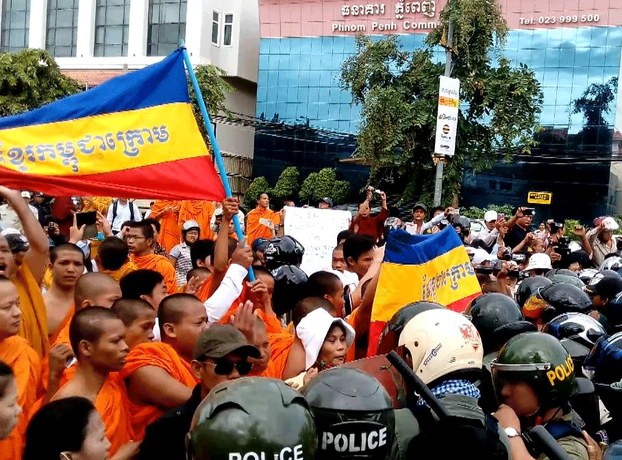




More than a hundred monks and students from Vietnam’s Khmer Krom ethnic minority living in Cambodia clashed Tuesday with riot police and security guards in front of the Vietnamese embassy in Cambodia’s capital Phnom Penh as they marched to demand an apology for statements by Hanoi claiming historic ownership of disputed territory.
Police used batons to disperse the protesters, who responded by hurling stones, sources said. Several marchers were injured in the clash.
Speaking at Tuesday’s rally, Federation of Cambodian Intellectuals and Students president Mao Peises rejected a Vietnamese diplomat’s statement made to the Cambodian media in June that Khmer Kampuchea Krom, a region comprising much of present-day southern Vietnam, belonged to Vietnam even before it was officially ceded to it by France in 1949.
Opposition Cambodia National Rescue Party (CNRP) lawmaker Riel Khemarin, also participating in the protest, called on Trung Van Thong, the Vietnamese diplomat at the embassy in Phnom Penh who made the statement, to publicly apologize.
Speaking later to RFA’s Khmer Service, Thong rejected the protesters’ demand for an apology, saying the marchers’ actions were “in violation of Cambodian law.”
“Southern Vietnam belongs to Vietnam,” he said. “I have already said this many times, and I reiterate it now.”
“France did not cede any Cambodian land to Vietnam, or any Vietnamese territory to Cambodia. I am telling the truth,” he said.
Excessive force
Cambodian rights group Adhoc meanwhile condemned the “illegal use” of municipal security guards to attack the protesters and prevent them from peacefully presenting a petition to the embassy.
“This is an abuse of [Cambodia’s] constitution and a violation of human rights,” the group said in a statement Tuesday.
Beehive Radio founder Mam Sonando, a participant in the protest, also criticized the government for using what he called excessive force to crack down on marchers, citing concerns for Cambodia’s “reputation.”
France’s Cochinchina colony, which included the former provinces of Kampuchea Krom, was officially ceded to Vietnam in 1949, but had been under Vietnamese control since the mid-17th century.
One of the most important seaports of Kampuchea Krom, once called Prey Nokor, is now known as Ho Chi Minh City—the financial hub of Vietnam and one of the largest cities in Southeast Asia.
Strict controls
Since Hanoi took control, the Khmer Krom living in Vietnam—believed to number considerably more than one million and who are ethnically similar to most Cambodians—have increasingly faced social persecution and strict religious controls, according to rights groups.
U.S.-based Human Rights Watch has said the Khmer Krom face serious restrictions of freedom of expression, assembly, association, information, and movement in Vietnam.
The Vietnamese government has banned Khmer Krom human rights publications and tightly controls the practice of Theravada Buddhism by the minority group, which sees the religion as a foundation of their distinct culture and ethnic identity.
On the other side of the border, the Khmer Krom who leave Vietnam for Cambodia remain one of the country’s “most disenfranchised groups,” Human Rights Watch said.
Because they are often perceived as Vietnamese by Cambodians, many Khmer Krom in Cambodia face social and economic discrimination.
They also face hurdles in legalizing their status in the country, as authorities have failed to grant many Khmer Krom citizenship or residence rights despite promises to treat them as Cambodian citizens, according to Human Rights Watch.
Reported by Den Ayuthyea and Samean Yun for RFA’s Khmer Service. Translated by Samean Yun. Written in English by Richard Finney.